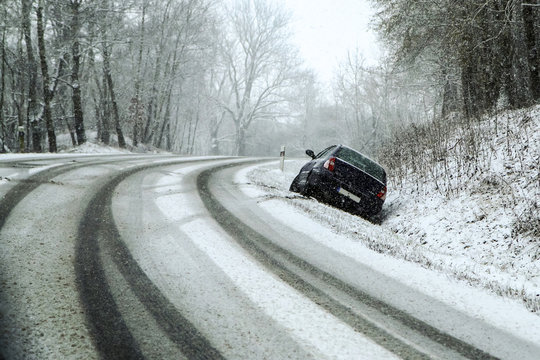Driving Safely On Snow

Now that we have had our “first snowfall” of the season. We know that more is in store for us this winter. Driving on snow can be dangerous. It’s important that you take the necessary precautions to ensure that you arrive at your destination safely.
1. Decrease Speed
Winter driving is all about slowing down, giving yourself plenty of distance between vehicles in front and to the side of your vehicle. Lower your speed to account for poorer traction. A vehicle’s tires will slide on snow and ice, so gently press down on the brake pedal to stop. Your tires will spin when accelerating, so gently press down on the accelerator to go. Remember, bridges and overpasses freeze first.
2. Remove Snow and Ice
Before you clear off the windows, start the car, set the airflow to defrost, the fan speed to maximum and the temperature to high. The goal is for the driver to have an unobstructed view in all directions.
Carry a brush to remove snow on the vehicle’s roof, hood, trunk lid, and all windows before driving. Use a scraper or a credit card if necessary, to remove ice on the car windows and mirrors.
Also, make sure the inside window glass is clean in all directions. It can take longer to defrost ice and snow if the rear glass is dirty. Also, check to see if the rear-window defroster is working. Be careful when cleaning the glass to avoid damaging the defroster wires.
3. Minimize Distractions
There are always distractions that come into play as part of everyday driving – the temptation to speak on the cell phone, turn on a podcast, or anything else.
4. Stay Home
If the weather is bad, stay home. Only go out if necessary.
5. Keep a Full Tank of Gas
Fill up your gas tank ahead of the storm and keep it full. You don’t want to run out of gasoline if you end up stuck for hours in bumper-to-bumper traffic during a snowstorm, sleet or ice storm. When the tank gets half empty, fill it up.
6. Respect Snowplows
Snowplow drivers focus on clearing roadways. At the same time, the snowplow driver may be on the radio getting instructions from a superintendent. As a result, it could be that peripheral vision gets obstructed by the flying snow and the truck’s big snowplow. The driver may not see your vehicle.
In addition, watch out when driving next to a snowplow on a major roadway. The snow that flies off the sides of the plow can hit your windshield making it difficult to see the road. To be safe, keep a distance from any snowplow on the road.
7. Don’t Use Cruise Control
Resist the urge to use cruise control when driving in snow, ice or slush. The road may be wet, but there still might be black ice or unplowed snow ahead.
These conditions could result in losing control of the vehicle when driving on cruise control because the system may not react as quickly as you can if you feel a loss in traction.
8. Check Tire Pressure and Tread
Check tires monthly to determine that each tire is properly inflated and that each has a sufficient amount of tread. If the tread looks worn down, replace your tires. That’s where your local automotive dealership service department or tire retailer comes in, supplying you with the same Original Equipment Manufacturer (OEM) tires that your vehicle was wearing when it first rolled off the assembly line.
9. Clean Headlights, Taillights
Lights can get quickly covered with snow, ice, and slush. Use a rag, tissue, paper towel or a newspaper to clean each light. As a driver, you want to see as far as possible ahead and you want drivers to see you, too.
A headlight’s or taillight’s visibility can be reduced by over 50 percent if the lights are covered with winter grime. Keep extra microfiber towels in the car for this purpose.
10. Be on the Lookout for Black Ice
The pavement looks wet but it is actually ice-covered. Black ice is the term used to describe this condition. During the day the ice and snow may thaw, but as the temperature drops in late afternoon or evening, the water may turn to ice on the roadway.
If you have been in a car accident and need an injury attorney, it is natural to have questions and concerns in the aftermath of a painful, traumatic event. Call us for a free consultation at 816-888-8010 or complete our online questionnaire and allow one of our experienced personal injury lawyers to answer all of your questions.

